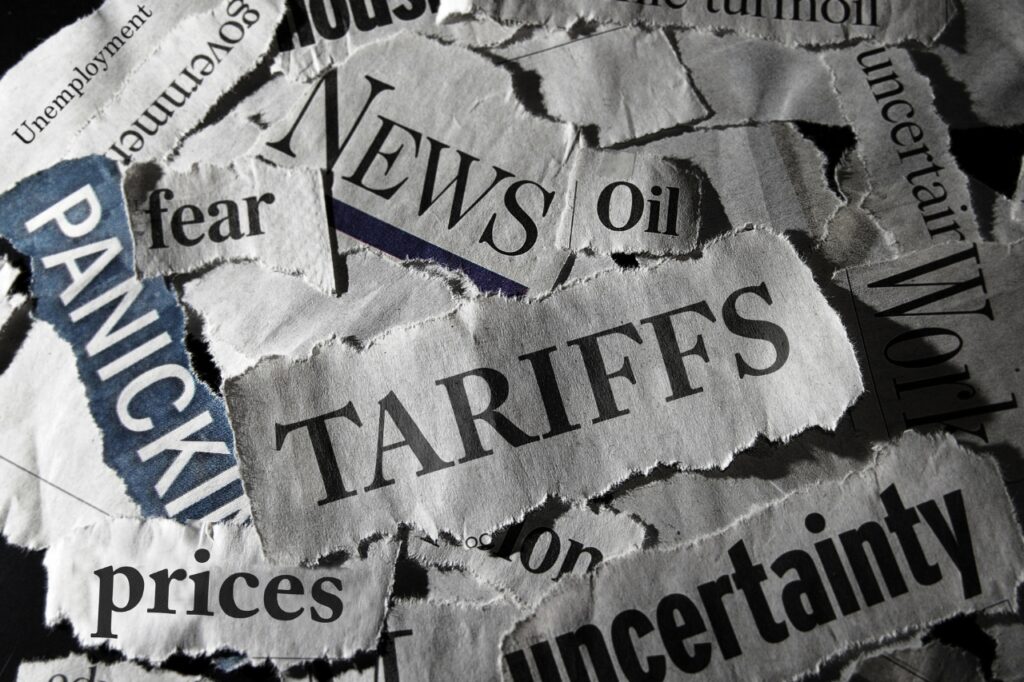I recently read an article titled “Woman Foolishly Thinks She Just Needs To Get Through This Week.” The headline made me laugh out loud as I read on; I started to identify with the article’s subject: “Each Monday morning, we catch up in the office over coffee, and she just repeats how she just needs to make it through the week… it’s been 52 weeks, and nothing has changed.” The more I thought about it, the more I realized that is what we, as supply chain pros, have been doing. Waiting for things to get back to “normal,” but knowing it likely won’t ever be like 2019 again. Those who embrace that change is inevitable are far more likely to remain competitive and thrive than those who are not.
The Myth of the New Normal
Remember when the word “unprecedented” was everywhere? Every email started with “In these unprecedented times…” Fast forward, and here we are, sipping our umpteenth cup of home-brewed coffee, talking about settling into the ‘New Normal.’ But let’s be honest. The truth of the matter is that “normal” is a myth. I have never been a fan of the term “new normal.” The Greek philosopher Heraclitus is credited with saying, “The only thing constant in life is change.” As we progress through time, we would be better served to acknowledge the current conditions and strive to adapt to them rather than hope that things will return to the way they were. We should always be moving forward and learning from the past but never planning that it will return. In our supply chain industry, this means adapting to ongoing factors requiring changes to remain competitive, such as embracing new technologies, adapting to shifts in global trade patterns, or reconfiguring logistics networks for greater resilience and flexibility. A “New Normal” mindset suggests that a period of stability soon follows once we adapt to changes. And while this may be the case, it will not last. If we become complacent and comfortable and think we are done changing because we have obtained success in the “new normal,” as Benjamin Franklin wrote, “When you are finished changing, you are finished.”
Embracing the VUCA World: The End of “React and Respond”
When it comes to supply chain performance, our reality is we are challenged with maintaining consistent performance mainly because we set our performance expectations and plans without considering volatility or uncertainty. Our supply chains operate in an environment characterized by Volatility, Uncertainty, Complexity, and Ambiguity — a VUCA environment.
The term VUCA originated from the U.S. military at the end of the Cold War. It was first used in the early 1990s to describe the more volatile, uncertain, complex, and ambiguous multilateral world that emerged after the fall of the Soviet Union. This era, characterized by rapid change and unknowns, challenged the military’s conventional approaches to strategy and leadership that had been used previously (sound familiar?)
It was intended to help leaders and military strategists understand the changing nature of challenges and prepare for the unpredictability of conflict. Leaders and strategists found that the components of VUCA were not only applicable to post-Cold War military scenarios but also to the rapidly evolving, increasingly complex global business environment.
Volatility: The Roller Coaster of Change
Market demand fluctuates wildly as geopolitical tensions rise, mergers & acquisitions increase, and technology rapidly changes the playing field. The rate and scale of change are accelerating across the supply chain, leaving little room for the complacent or unprepared.
Uncertainty: The Fog of the Future
If there’s one sure thing, it’s uncertainty. Trying to forecast in today’s environment can often feel like navigating through a thick fog. Supply chain disruption, consumer trends, economic conditions, and even global health situations can shift dramatically and with little warning. This uncertainty makes design, planning, forecasting, and execution challenging and critically important.
Complexity: The Web of Interconnectivity
When I hear the word “chain,” I see images of objects connected one after another in a linear fashion. However, most supply chains are far from simple linear systems; they constantly change complex networks of suppliers, manufacturers, distributors, logistics entities, retailers, and customers. Each node in the network can be affected by external and internal factors, creating a complex web that is difficult to manage and control. This interconnectivity means issues in one area can quickly affect the network.
Ambiguity: Multiple Interpretations of Reality
What’s the right strategy or decision? Which trend should we follow? Often, the path forward is not clear-cut. Ambiguity in business means that the same data or scenarios can be interpreted in multiple ways, leading to differing strategies and outcomes. This necessitates a robust and flexible approach to decision-making and strategy formulation guided by “there is no one right answer.”
Moving Forward: Decision Engineering for Agility and Resilience
Understanding, accepting, and embracing VUCA is the first step. The next step is to develop the agility and supply chain resilience needed to thrive and make better decisions. This mindset means creating flexible strategies, investing in robust technologies like GAINS, and fostering a culture of continual learning and improvement. It’s about moving from “just surviving” to “thriving” using the best math and science to approach every decision – and having access to deep domain experts to guide you.
In prior decades, supply chain leaders had the luxury of operating with higher degrees of predictability and certainty due to greater stability and lower complexity levels. The approaches, methods, and tools created 30-plus years ago and tweaked through today were engineered for that environment. These approaches have not served us well recently because the underlying conditions have changed and evolved to a new state. Supply chain performance had been stagnating and declining before the pandemic. Sadly, it took the magnitude and impact of COVID to open the eyes of business executives and supply chain leaders and show them that a different approach is needed. Today’s global market is anything but stable and straightforward. Companies across the board need to develop playbooks for anticipated market changes, understand the tradeoffs of every decision, and explicitly incorporate variability and uncertainty to ensure they meet or exceed their goals and objectives. Supply chain operations in VUCA conditions face a daily barrage of decisions akin to navigating a ship through a relentless storm. The quest for optimal inventory levels, reducing the landed cost of materials and services, and juggling variable lead time through global outsourcing or multi-sourcing is now more challenging than ever. A new approach is needed: Decision Engineering.
How can supply chain experts navigate these turbulent waters?
As we continue through the complexities and challenges of a VUCA environment, one thing becomes abundantly clear: traditional methods and tools are no longer sufficient. This is where the GAINS platform comes into play, offering a robust suite of solutions designed to help supply chain professionals successfully navigate the VUCA world.
GAINS: Decision Engineering to Direct Your Path
In the face of volatility, the GAINS platform acts as a compass, providing advanced predictive analytics and demand forecasting. GAINS helps companies stay one step ahead, turning volatility from a daunting challenge into a navigable aspect of supply chain management.
Empowering Agility and Continuous Improvement
GAINS is not a traditional software vendor but a partner and solution provider fostering a culture of agility and continuous improvement. We help customers identify the decisions that drive better performance. With GAINS, companies are not just reacting to VUCA conditions; they are proactively navigating through it, ready to adapt and thrive amid change.
Cutting Through the Uncertainty
The GAINS platform offers robust scenario planning and risk management tools, cutting through the fog of uncertainty and clouding supply chain decisions. With GAINS, supply chain professionals can simulate various market conditions, understand potential impacts on the supply chain, and make informed decisions, significantly reducing the paralysis that uncertainty can cause.
Simplifying Complexity with Integrated Solutions
GAINS understands that modern supply chain operations are vast webs of interconnected nodes, living and breathing entities in constant change. The platform brings coherence to complexity, enabling seamless coordination across various supply chain components through a composable architecture. GAINS provides a unified view from suppliers to customers, ensuring that every decision considers the entire network and the constraints along the way.
Clarifying Ambiguity with Data-Driven Insights
In an ambiguous world, the clarity that data-driven insights provide is invaluable. GAINS transforms vast amounts of data into actionable decisions, helping supply chain professionals understand market trends, buying behaviors, and operational efficiencies. GAINS replaces ambiguity with clarity, guiding better strategic and tactical decisions, no matter what the day may bring.
Navigating the Future with GAINS
As we journey through the VUCA world, the GAINS Performance Optimization Platform is a beacon of innovation, strategy, and supply chain resilience. It is not just about surviving the era of volatility, uncertainty, complexity, and ambiguity; it’s about thriving in it, understanding the impact of decisions across your network, and turning potential threats into opportunities for growth and success.
As supply chain professionals, the choice is ours: continue to tread water in the hope of a return to the mythical ‘normal,’ or chart a confident course through VUCA with GAINS at the helm. The future of supply chain management is here, powered by GAINS.
Jeff Metersky is a 38-year Supply Chain Veteran and VP of Solution Design at GAINS. For more from Jeff, follow the links below.
Other Reading
The Evolution of Supply Chain Design: From Mainframes to Modernity By Jeff Metersky
LISTEN to Jeff on the GAINS On Podcast
Mastering Risk Mitigation: Unleashing the Power of Supply Chain Design By Jeff Metersky


